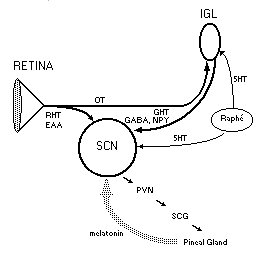
| FIG. 4 |
 |
| Schematic representation of the major neural components of the mammalian circadian system (based on information in ref. 25). Light information is transduced by the retina and reaches the suprachiasmatic nuclei (SCN) directly via the retinohypothalamic tract (RHT), and indirectly via the optic tract (OT) to the intergeniculate leaflet (IGL), and then via the geniculohypothalamic tract (GHT) to the SCN. The raphé nuclei project to both the IGL and SCN. An important efferent pathway from the SCN leads to the paraventricular nucleus (PVN), and an important subparaventricular zone. This pathway projects to the intermediolateral nucleus of the spinal cord and passes to preganglionic adrenergic fibers of the sympathetic nervous system, and thus to the superior cervical ganglion (SCG) which provides final sympathetic input to the pineal gland. The hormonal feedback of melatonin on melatonin receptors in the SCN is indicated by the dotted line. Putative neurotransmitters for each neuronal tract are identified as: EAA, excitatory amino acids; NPY, neuropeptide Y; 5HT, serotonin; GABA, g-aminobutyric acid. |
| Back to Chapter |
published 2000